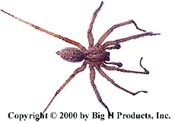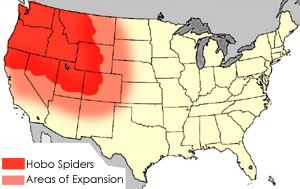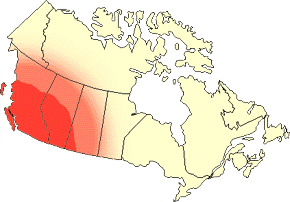Identify A Spider - Learn
about Brown Recluse - FAQ - Q&A
at the Spider Forum - Order Traps

What do Hobo Spiders look like?
 Hobo
Spiders are brown and measure roughly 12 to 18 mm in length. Their legs
show no distinct rings and have short hairs. Their abdomens have several
chevron shaped markings.
Hobo
Spiders are brown and measure roughly 12 to 18 mm in length. Their legs
show no distinct rings and have short hairs. Their abdomens have several
chevron shaped markings.
Males are distinctively different from females in that they have two
large palps that look like boxing gloves. These palps are often mistaken
for fangs or venom sacs, but they are in fact the male genitalia. The
females also have these palps, but the ends are not 'swollen' as they
are on the males. Females tend to have a larger abdomen when compared
to males.
Where do Hobo Spiders live?
 |
 |
Anywhere in Washington, Oregon, Idaho, Montana, Wyoming, Utah, Colorado, Southern British Columbia Hobo Spiders can be found. We feel that it is likely that there are Hobos in Northern California. We have also received spider samples from the many parts of Mid-West and North Eastern USA which appear to be Hobo spiders.
 The
hobo spider creates a non-sticky (in spider standards) trip web that doesn't
permanently stick insects to the web. Instead, once the prey trips on
the web the hobo spider attacks the prey before it can get away. This
along with its poor eye site explains why they are noticeably more aggressive
to humans then other spiders. They have to attack to eat otherwise they
would die of starvation.
The
hobo spider creates a non-sticky (in spider standards) trip web that doesn't
permanently stick insects to the web. Instead, once the prey trips on
the web the hobo spider attacks the prey before it can get away. This
along with its poor eye site explains why they are noticeably more aggressive
to humans then other spiders. They have to attack to eat otherwise they
would die of starvation.
Their webs are funnel shaped and are often attached to an object in the yard--by the foundation--between planters, or anything that remains stationary near the ground level. It also makes webs under the siding of homes and attaching to plants or weeds.
Here is an example of a large hobo spider web--20% of actual size. Most
webs are not as obvious and large, these are pictures taken between 2
planters for new trees.
How do I know if I've been bit?
 To the
left is a picture of a Hobo Spider bite. About 50% of Hobo Spider bites
are 'dry,' meaning that no venom is injected, and nothing happens to the
victim. Often times the victim does not even realize that he has been
bit.
To the
left is a picture of a Hobo Spider bite. About 50% of Hobo Spider bites
are 'dry,' meaning that no venom is injected, and nothing happens to the
victim. Often times the victim does not even realize that he has been
bit.
Typically, when venom is injected, the victim will experience an immediate redness which develops around the bite, then begins to disappear within a few hours. Very often, for the first 24 hours, the bite appears to be no worse than that of a mosquito; then it begins to blister in the center. Within 24 to 36 hours the blister breaks open leaving an open, oozing ulceration.
This ulceration 'scabs' over within three weeks from the initial bite, leaving a permanent scar. If the bite is delivered in fatty tissue, the lesion may be very deep and extensive and not heal for two or three years. Systematic reactions to Hobo Spider poisoning include severe headaches, nausea, vomiting, soreness, and flu-like symptoms.
In extreme cases where the bite was not taken care of early, skin graft,
amputation, and the possibility of bone marrow failure may occur.
How can I control them?
Pre-baited traps have shown to be the most effective means available to control Hobo Spider populations.
In order to kill Hobo spiders with pesticides you usually have to hit the spider directly with large doses. The problem with non discriminate spraying is that you kill the good competitor and predator spiders and insects and thus make more room for the more mobile and hardy Hobo spider. This will often lead to a worse problem with Hobo spiders as one man witnessed in 1997 in his own home.
Find a Local Reseller Order Online Here!
Learn about Brown Recluse Spiders.
Read Frequently
Asked Questions.
Have your questions answered in our Forum.